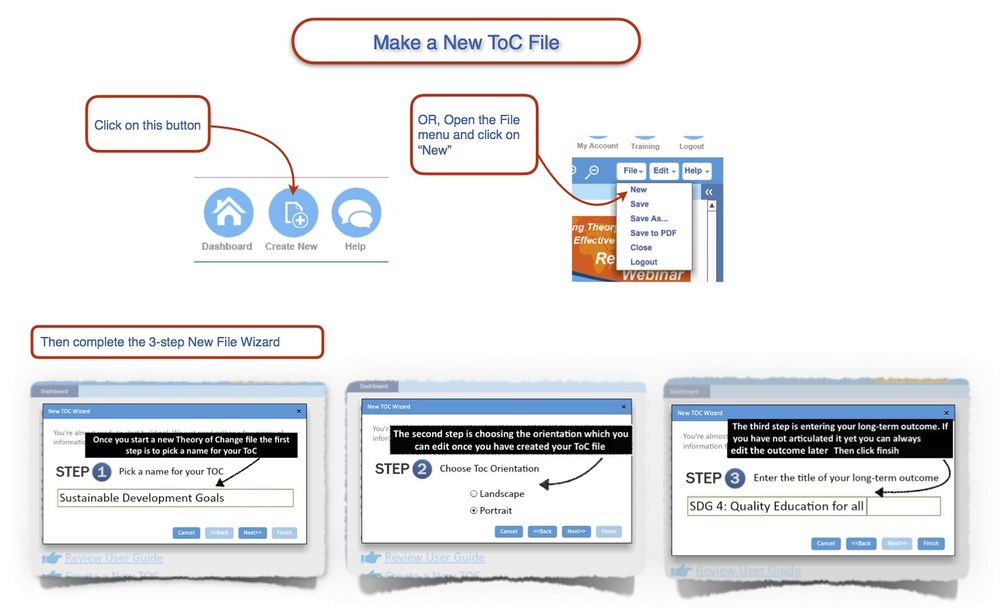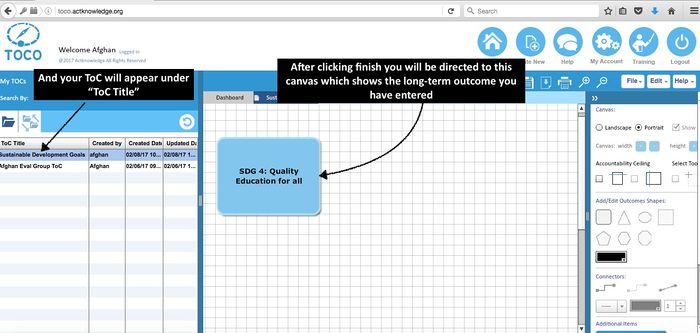(→Formatting Options -- Full-Text Display) |
(→How to Create a new ToC file) |
||
| Line 15: | Line 15: | ||
Follow the 3-step wizard: 1) Name the ToC File. 2) Choose landscape or portrait format for the ToC diagram (Note: you can now change from one to the other at any time). 3) Enter title (expression) of the long-term outcome (If you haven't articulated it yet no worries, you can edit the outcome or delete it at any time.) | Follow the 3-step wizard: 1) Name the ToC File. 2) Choose landscape or portrait format for the ToC diagram (Note: you can now change from one to the other at any time). 3) Enter title (expression) of the long-term outcome (If you haven't articulated it yet no worries, you can edit the outcome or delete it at any time.) | ||
| − | |||
---- | ---- | ||
| − | After completing the wizard a canvas opens up showing the one outcome already created. | + | After completing the wizard a "canvas" opens up showing the one outcome already created. The canvas or drawing board is where you draw your Theory of Change diagram. On the canvas you can add outcomes, connectors, interventions, etc. |
[[File:Last step.jpg|700px|]] | [[File:Last step.jpg|700px|]] | ||
Revision as of 07:17, 15 February 2017
Contents
How to Create a new ToC file
You must be logged into TOCO!
To start a new Theory of Change, either click on "Create New" button on top right corner or select "New" from the File menu.
Note: Free and Premium users can also click on the "Create a New TOC" hypertext on your dashboard to start a new ToC file.
Follow the 3-step wizard: 1) Name the ToC File. 2) Choose landscape or portrait format for the ToC diagram (Note: you can now change from one to the other at any time). 3) Enter title (expression) of the long-term outcome (If you haven't articulated it yet no worries, you can edit the outcome or delete it at any time.)
After completing the wizard a "canvas" opens up showing the one outcome already created. The canvas or drawing board is where you draw your Theory of Change diagram. On the canvas you can add outcomes, connectors, interventions, etc.
The video below takes you through the process of creating a new ToC, adding and editing outcomes, adjusting font size and color and changing outcome fill color.
Draw Connector & Edit Connector Shape
Connectors can be drawn only by clicking on the connector icon on an existing outcome box. See illustration here [[1]]
The video below demonstrates how to draw connectors and edit the connector shape.
To edit an existing connector you can:
- Change connector shape from the default right-angled, three-leg connector to a) "Rounded-corner," which is right-angled but with rounded corners; or to b) "Straight line," which changes the shape to a single straight line segment.
- This can be done either by selecting the connector and clicking the preferred shape on the canvas tool panel or by right-clicking on the connector and choosing the preferred item on the menu.
- Change connector shape from solid line to dotted or dashed line, and make line weight lighter or heavier, using tools on the panel.
- Change color using color selector on panel.
You can adjust the placement of the middle leg of a right-angle or rounded-corner connector, as shown in the video.
* Note: If you change position or size of a connected outcome box after adjusting connector line placement, the line will snap back to its default position. You may want to defer painstaking line placement adjustments until the disposition of outcomes on your canvas is reasonably final.
Formatting Options -- Full-Text Display
Interventions and Rationales are entered in the connector editor. Ordinarily, rationales and interventions are displayed in code on the ToC diagram and reported in full in the data export. With TOCO 2.0 you have the option of displaying rationales and interventions in full text on the diagram. Video below explains how.
Select, Drag, Copy, Paste
TOCO has a crosshair-select feature available on the canvas tool panel [[2]]. The above video demonstrates using the select tool
to move parts of your diagram around on the canvas and to copy and paste some or all the content to another ToC file.
Grouped Outcomes
You can group outcomes together. To do this, create a new outcome. Using the sizing handle in the lower right corner of the outcome object, shape the outcome box so that it’s big enough to surround the outcomes you want to group together. Then drag the new outcome box over the group to cover the “child” outcomes leaving a surrounding margin (as shown above). Then right-click on the grouping outcome object and select "send to back." The child outcomes will then be collected by the grouping object and the outcome title will automatically slide up to the top edge so as not to disappear behind the child outcomes.
You may want to make color choices that allow the individual boxes to stand out against the background, as in this example.



